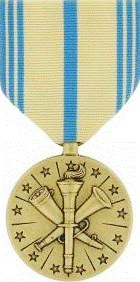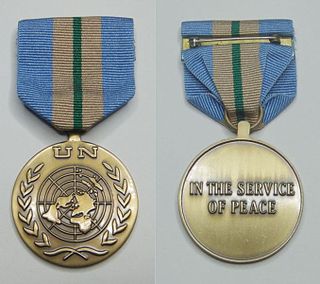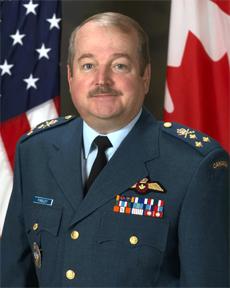The Commendation Medal is a mid-level United States military decoration presented for sustained acts of heroism or meritorious service. Each branch of the United States Armed Forces issues its own version of the Commendation Medal, with a fifth version existing for acts of joint military service performed under the Department of Defense.

The United States Armed Forces awards and decorations are primarily the medals, service ribbons, and specific badges which recognize military service and personal accomplishments while a member of the U.S. Armed Forces. Such awards are a means to outwardly display the highlights of a service member's career.
An Arabic numeral device or numeral device sometimes called an "award numeral", is a United States Armed Forces service device that may be authorized for wear on specific service ribbons and suspension ribbons of medals. Arabic numeral devices are bronze or gold in color and are 3⁄16 inch in height.
The Armed Forces Expeditionary Medal (AFEM) is a military award of the United States Armed Forces, which was first created in 1961 by Executive Order of President John Kennedy. The medal is awarded to members of the U.S. Armed Forces who, after July 1, 1958, participated in U.S. military operations, U.S. operations in direct support of the United Nations, or U.S. operations of assistance for friendly foreign nations.

The Armed Forces Reserve Medal (AFRM) is a service medal of the United States Armed Forces that has existed since 1950. The medal recognizes service performed by members of the reserve components and is awarded to both officers and enlisted personnel. The medal is considered a successor award to the Naval Reserve Medal and the Marine Corps Reserve Ribbon, which were discontinued in 1958 and 1967, respectively.
The Armed Forces Service Medal (AFSM) is a military award of the United States military that was created on January 11, 1996, by President Bill Clinton under Executive Order 12985. The AFSM is a deployed service medal that is presented to those service members who engage in "significant activity" for which no other U.S. campaign or service medal is authorized.

A United Nations Medal is an international decoration awarded by the United Nations (UN) to the various world countries members for participation in joint international military and police operations such as peacekeeping, humanitarian efforts, and disaster relief. The medal is ranked in militaries and police forces as a service medal. The United Nations awarded its first medal during the Korean War (1950–1953). Since 1955, many additional United Nations medals have been created and awarded for participation in various United Nations missions and actions around the world.
An international decoration is a military award which is not bestowed by a particular country, but rather by an international organization such as the United Nations or NATO. Such awards are normally issued as service medals, for participation in various international military operations, and not for specific acts of heroism or bravery.
The NATO Medal is an international military decoration which is awarded to various militaries of the world under the authority of the North Atlantic Treaty Organization (NATO). It is manufactured by Eekelers-Centini Intl, of Hemiksem, Belgium.

The Multinational Force and Observers (MFO) is an international peacekeeping force overseeing the terms of the peace treaty between Egypt and Israel. The MFO generally operates in and around the Sinai peninsula.
The following is the Canadian order of precedence for decorations and medals. Where applicable, post-nominal letters are indicated.

This is a list of Norwegian orders and medals, in order of precedence. This list contains all medals approved for wearing on a Norwegian military uniform in ranked order.

Lieutenant-General Eric A. "Rick" Findley, CMM, MSC, CD is a retired officer in the Royal Canadian Air Force and was the Deputy Commander of the North American Aerospace Defense Command (NORAD) from July 2003 through August 2007.

The Australian Service Medal is an Australian military decoration. It was authorised 13 September 1988 to recognise prescribed service in peacekeeping and non-warlike operations. It is awarded with a clasp to denote the prescribed operation and subsequent awards of the medal are made in the form of additional clasps. The Australian Service Medal 1945–1975 recognises non-warlike service prior to February 1975.
An international decoration is a military award which is not bestowed by a particular country, but rather by an international organization such as the United Nations or NATO. Such awards are normally issued as service medals, for participation in various international military operations, and not for specific acts of heroism or bravery. The first medal from an international organization accepted for wear by the United States Military was the United Nations Korea Medal in 1951. Subsequent acceptance of other United Nations Medals did not come until 1964 with Executive Order 11139. Acceptance of the medals of other international multilateral organizations finally came with Executive Order 11446 in 1969. Acceptance of these international decorations must be approved by not only the Secretary of Defense, but also the Secretary of State.
The General Campaign Star is a campaign medal created in 2004 by the Canadian monarch-in-Council to recognize members of the Canadian Armed Forces who had directly participated in any military campaign under Canadian or allied command. It is, within the Canadian system of honours, the sixth highest of the war and operational service medals.
Civilian employees working for the Multinational Force and Observers mission in the Sinai are authorized the MFO Civilian Medal in recognition of their service in the cause of peace.
The Special Service Medal is a service medal awarded to members of the Canadian Forces. The medal was established by letters patent by Queen Elizabeth II on 16 June 1984. Recipients of this medal must have performed, "service under exceptional circumstances". The medal is always issued with a bar which specifies the special service which the medal recognizes. Each bar has its own criteria.







